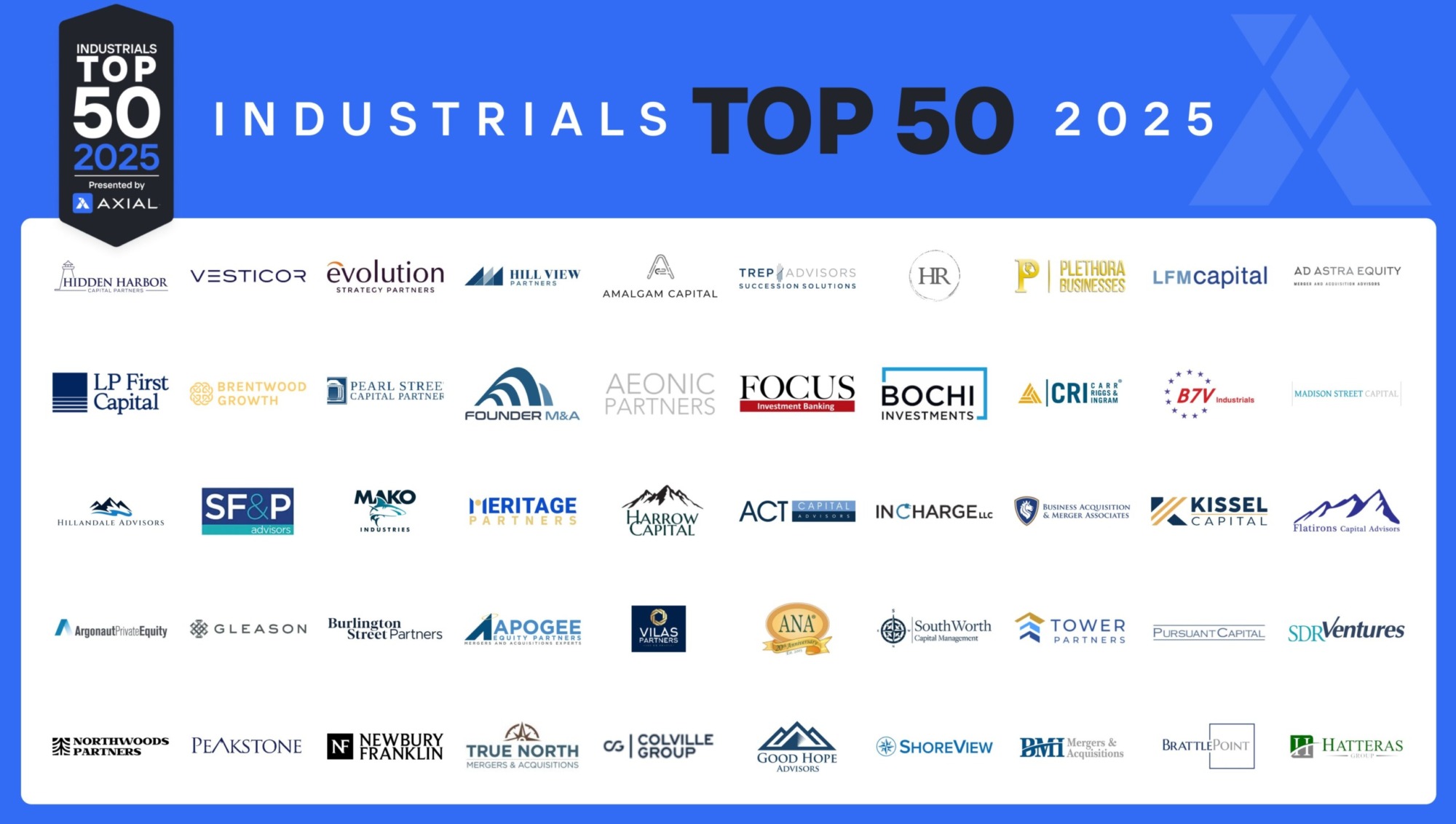
The Top 50 Lower Middle Market Industrials Investors & M&A Advisors [2025]
Industrials remains the most dominant sector in Axial deal flow, representing more than 25% of all deals brought to market…
Thompson Reuters has been measuring private equity activity on a month-to-month basis since 1978 and, according to recently published research, 2016 showed the fewest completed January middle market M&A deals since 1991. Just 121 deals were completed, virtually half of the 241 such deals in 2015. Thanks to swollen equity valuations, the total value was still $15.7 billion – far below 2014 or 2015 deals, but about on par with 2010 figures.
We anticipated this sentiment, to some extent, by expecting private equity deals to be fewer in 2016 but likely to “see higher returns because asset prices will be less inflated.” This should be especially true if multiples begin to normalize throughout the year — cheaper entry should allow for more profitable exits down the road.
According to PitchBook data, multiples were already rapidly shrinking last year from peaks in 2014. Using EBITDA as the benchmark, multiples slid in all areas: debt (6.6x in 2014 to 5.1x in 2015), equity (4.4x to 4.0x), and valuation (11.1x to 9.1x).
The January results continue the trend from 4Q2015, where deals were down about a full quarter from the same period in 2014. The slump can be attributed to several factors, but I’d like to focus on three: increasing asymmetry between buyer and seller expectations, higher number of important and difficult-to-quantify diligence items, and financing concerns.
To borrow an economics term, we’re in a period of disequilibrium between buyer and seller expectations, particularly in lower middle market deals.
Sellers have grown accustomed to sky-high valuations (9.5x – 11x EBITDA) since 2011, and many enter the diligence and negotiation stages with similar numbers. On the back of buoyant equity markets, industry activity (in terms of annual deals closed) grew 53.9% from 2010 to 2014.
While sellers are backwards-looking, buyers need to be forward-looking. Buyers are staring rising rates and market volatility in the face. They’ve witnessed the caution in mid-market activity for six months now. They see an uncertain tax and regulatory environment with the 2016 elections on the horizon. They know the good times can’t last forever.
Remember, PE buyers have to make their exits, too, and many aren’t sure they can make good on their investment after paying such a premium on the front end. It’s natural for buyers to adjust their outlook faster than sellers, and value gaps suppress deal volume.
Many of the sellers in the lower end of the middle market are entrepreneurs who don’t have a ton of private equity industry experience. Many know they don’t possess the technological or logistical savvy to continue to create value, or perhaps they’ve decided that now is too good of an opportunity to pass up and are looking to retire while the market is hot. In these conditions, unrealistic expectations and lack of familiarity act as shackles to deal realization.
M&A due diligence is always evolving and adapting to new challenges. Contemporary dealmakers, for example, need to shore up their IT diligence. Firms are constantly adjusting their tax or legal diligence processes.
For 2016, high-profile diligence items represent unique challenges. For instance, how do you price in the possible ramifications of the 2016 elections? Does the company have an effective understanding of present and future costs under the Affordable Care Act?
Dealmakers have to price in interest rates, the strengthening of the US dollar in cross-border transactions, energy markets, and public market volatility.
Meanwhile, regulatory complications hurt smaller funds that might be more eager to take on lower-middle market deals. “It’s becoming sad,” explains Marc A. Utay, Managing Partner of Clarion Capital Partners, LLC. “It’s a lot more costly. The SEC, the compliance attachments, the level of reporting and granularity of that is all increasing. Now you have to have a financial staff that can handle all of that. The economies of scale favor the larger funds.”
Interest rates are especially complicating. In December, the Federal Reserve raised its targeted Fed Funds rate from a 0.00 – 0.25 bps target to a 0.25 – 0.50 bps target. The Fed already announced it anticipates raising rates several more times, although timing is vague (and recent reports suggest Yellen is testing the waters on reversing course or even going negative!).
Many mid-market buyers will hold onto their assets for three to five years, by which time interest rates may be much higher than they are today. There’s very little chance that recent multiples hold up in such an environment. Few funds are willing to enter into arrangements with significant multiple compression.
After the diligence process, investors still need to put together enough financing to push a transaction through. Here, again, uncertainty in monetary policy is a hindrance.
“It’s the credit markets,” Kenneth Leon, equity analyst for S&P Capital IQ, told CNBC. “When they seize up, you can’t get deals done.”
One ray of hope: strategic acquisitions, which were up 50% in 2015. Historically, that activity trickles down to the middle market, even if it takes a while. Private equity-to-private equity secondary buyouts should be attractive, where there’s a greater realization among funds about where their comparative advantages are.
In other words, funds are more sophisticated about where they can add value most efficiently. These deals have a higher chance of completion in the short term, since both parties are ostensibly familiar with industry and market conditions.
Smaller deals will likely have an easier time than others when it comes to financing, says Monroe Capital CEO Ted Koenig. “The financing market for borrowers with EBITDA of $50 million or less is in good shape, so it will remain a sellers’ market, although it’s hard to predict past the election.”
So long as the diligence isn’t overbearing and the sellers are agreeable, there’s opportunity with smaller companies. As Richard de Silva, Managing Partner at Lateral Investment Management, explains, “Within the US economy, we believe that lower middle market companies with less than $100MM in revenues are the best positioned,” especially because “they have little or no reliance on exports.”
